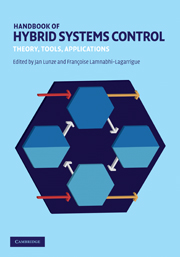Book contents
- Frontmatter
- Contents
- List of contributors
- Preface
- Notation
- Part I Theory
- 1 Introduction to hybrid systems
- 2 Survey of modeling, analysis, and control of hybrid systems
- 3 Hybrid automata
- 4 Switched and piecewise affine systems
- 5 Further switched systems
- 6 Hybrid systems: quantization and abstraction
- 7 Stochastic hybrid systems
- Part II Tools
- Part III Applications
- References
- Index
3 - Hybrid automata
from Part I - Theory
Published online by Cambridge University Press: 21 February 2011
- Frontmatter
- Contents
- List of contributors
- Preface
- Notation
- Part I Theory
- 1 Introduction to hybrid systems
- 2 Survey of modeling, analysis, and control of hybrid systems
- 3 Hybrid automata
- 4 Switched and piecewise affine systems
- 5 Further switched systems
- 6 Hybrid systems: quantization and abstraction
- 7 Stochastic hybrid systems
- Part II Tools
- Part III Applications
- References
- Index
Summary
Hybrid automata is a modeling formalism for hybrid systems that results from an extension of finite-state machines by associating with each discrete state a continuous-state model. Conditions on the continuous evolution of the system invoke discrete state transitions. A broad set of analysis methods is available for hybrid automata including methods for the reachability analysis, stability analysis, and optimal control.
Definition
A hybrid automaton is a transition system that is extended with continuous dynamics. It consists of locations, transitions, invariants, guards, n-dimensional continuous functions, jump functions, and synchronization labels. Various definitions exist in the literature which differ only in details. The following definition covers all of the aspects needed for the purpose of this handbook. A hybrid automaton consists of:
a finite set of locations Q, q ∈ Q;
a finite transition relation ⊖ ⊆ Q × Q
for the specification of the discrete dynamics. The locations can be seen as discrete states (also called control modes), in other words as the discrete part of the hybrid state space ℋ. Transitions from one control mode to the next are often called control switches. The continuous dynamics is described by:
a finite and indexed set of continuous variables V = {x1, x2, …, xn}, often written as a vector x = (x1, …, xn);
a real-valued activity function f : Q × ℝn → ℝn, often defined by a continuous differential equation ẋ = dx/dt = f(q, x).
- Type
- Chapter
- Information
- Handbook of Hybrid Systems ControlTheory, Tools, Applications, pp. 57 - 86Publisher: Cambridge University PressPrint publication year: 2009
- 3
- Cited by

